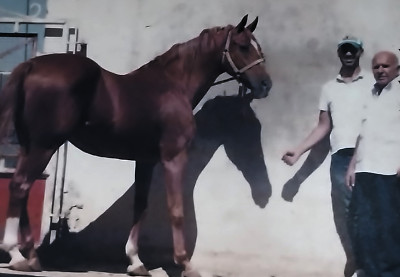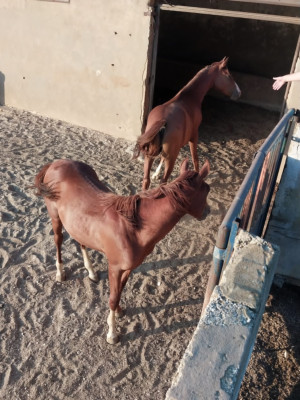Horse Breading in Lebanon
 Horse breeding and racing is a long tradition in Lebanon. Bekaa (Ammiq, Zahleh, Bar Elias, Taraya, Baalbak) and Akkar (Khirbet el Joundy, Wadi Khaled) plains are famous for breeding horses. In the two regions, there are historical families whose name is associated with them. They own huge farms (starting with 20 horses and more), and large numbers of horses, supervised by people with experience in this field. Clans and families breeding horses have traditions, behaviors, and norms. Speeches, behaviors, and relationships on occasions (weddings, funerals, occasions for receiving guests) are governed by rules, as is horse riding.
Horse breeding and racing is a long tradition in Lebanon. Bekaa (Ammiq, Zahleh, Bar Elias, Taraya, Baalbak) and Akkar (Khirbet el Joundy, Wadi Khaled) plains are famous for breeding horses. In the two regions, there are historical families whose name is associated with them. They own huge farms (starting with 20 horses and more), and large numbers of horses, supervised by people with experience in this field. Clans and families breeding horses have traditions, behaviors, and norms. Speeches, behaviors, and relationships on occasions (weddings, funerals, occasions for receiving guests) are governed by rules, as is horse riding.
 Purebred Arabian horses go back to five origins from which the rest of the lineages branched off, and those origins are “Saqlawiya, Al-Kahila, Al-Subyan, Umm Arqoub and Al-Shuwaima.” Old people in Baalbak, often tell a story about the origin of those horses: « The origin of the Arabian horses is Yemen near the Ma’rib Dam, whose waters collapsed and overthrew the plants and animals near it. Five horses (or horses) were able to escape towards the Saudi desert, where they were found by five men, whose intention was to slaughter and eat them, but they were impressed by their beauty and speed in hunting, so they decided to acquire them. The first one was called “the cloak,” in reference to the draping of its owner’s cloak over its long hair. As for the second, it was called “Al-Shawiha or Arqoub” because it had crooked hocks (lower leg). The third is the blonde dotted with white moles, and its name is “Shwaima” (of which there are twenty species). In addition, the fourth is «Saqlawiya» (including twenty species). Finally, “Al-Kahila”, including more than 200 species (Al-Hamdaniya, Al-Wadnah, Al-Hadbaa, Al-Kharsa …)”. Also, a Bedouin poem indicates the lineages among which horses should be chosen or avoided and lists their qualities and faults.
Purebred Arabian horses go back to five origins from which the rest of the lineages branched off, and those origins are “Saqlawiya, Al-Kahila, Al-Subyan, Umm Arqoub and Al-Shuwaima.” Old people in Baalbak, often tell a story about the origin of those horses: « The origin of the Arabian horses is Yemen near the Ma’rib Dam, whose waters collapsed and overthrew the plants and animals near it. Five horses (or horses) were able to escape towards the Saudi desert, where they were found by five men, whose intention was to slaughter and eat them, but they were impressed by their beauty and speed in hunting, so they decided to acquire them. The first one was called “the cloak,” in reference to the draping of its owner’s cloak over its long hair. As for the second, it was called “Al-Shawiha or Arqoub” because it had crooked hocks (lower leg). The third is the blonde dotted with white moles, and its name is “Shwaima” (of which there are twenty species). In addition, the fourth is «Saqlawiya» (including twenty species). Finally, “Al-Kahila”, including more than 200 species (Al-Hamdaniya, Al-Wadnah, Al-Hadbaa, Al-Kharsa …)”. Also, a Bedouin poem indicates the lineages among which horses should be chosen or avoided and lists their qualities and faults.
Horse breeding follows a few basic principles. The horses are married to a “stallion” to ensure the quality of the offspring and from it the origins are descended from generation to generation. A pedigree certificate for a purebred Arabian horse is delivered: “So-and-so is the son of so-and-so, the son of so-and-so”. The stable for the born horse should be spacious and allow him to move. At the age of six months, his saddle and bridle begin. The horse is trained to run, to turn left and right starting from the age of one year, and it needs spaces to open its chest and increase its speed. Some horses are trained in ceremonial movements with music at weddings and receptions. At the age of two years, the stage of “takbiss” or riding the horse begins. Then it goes down to the racetrack. Races are organized on large fields and Beirut Hippodrome.
Horse breeding is a stand-alone sector, providing livelihood for many families and creating many job opportunities, more specifically to men. The family, from its oldest to its youngest, takes care of it, and everyone is keen on riding horses, taking care of them, and preserving their offspring. Talking about horses during family gatherings in homes is very common. Their qualities such as their virility, their magnanimity and their loyalty as well as their fidelity to their owners are constantly enumerated. There are stories that adults tell their grandchildren about the loyalty of the horse to its owner.
Horse breeding was a very flourishing sector before the civil war (1975-1990). The war dealt him a very hard blow from which he could not recover despite the efforts made by various associations. Currently, due to the economic crisis, Arabian horse breeders are trying hard to preserve this heritage, to revive this tradition inherited “from father to grandfather”, and to attract more amateurs and those interested by holding annual festivals and organizing races, to breathe life into this lumbering body.

